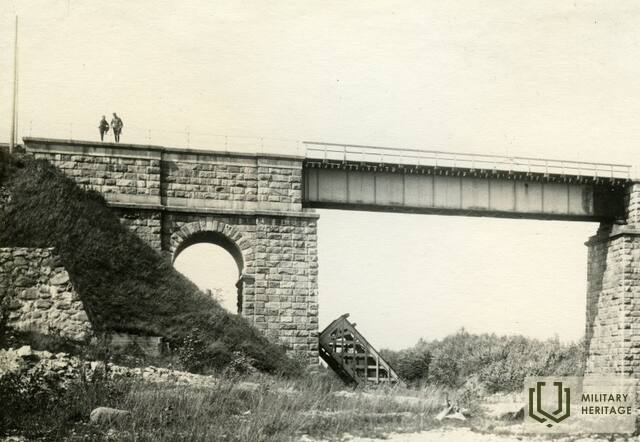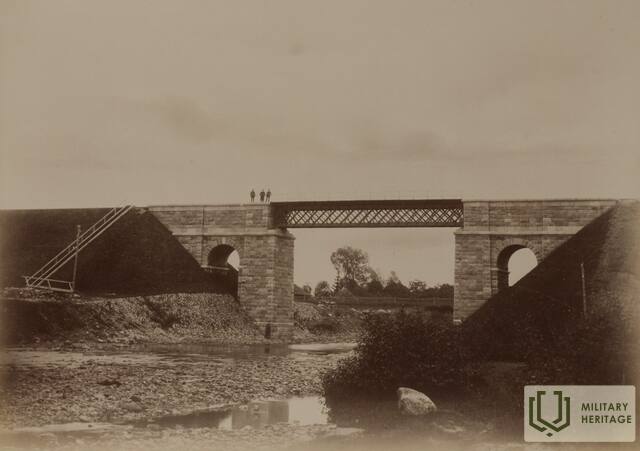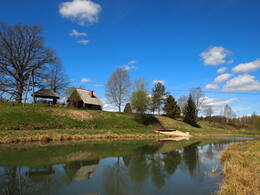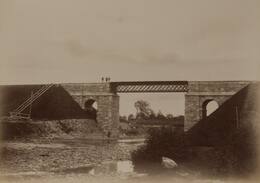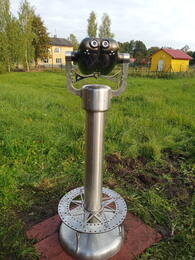Cėsių mūšis Amatos upės pakrantėje
Prie tilto per Amatą vokiečių landesveras puola deryboms atvykusį estų šarvuotą traukinį. Estai pradeda kontruguoti, vokiečiai atremiami, ir šarvuotas traukinys grįžta į Cėsį.
Visiškai neištirtas Cėsių mūšių puslapis yra susidūrimas prie tilto per Amatos upę 1919 m. birželio 5 d. vakare. Būtent čia vokiečių landesveras atskleidžia savo tikruosius ketinimus. Iki tol derybose vokiečiai tvirtina, kad Raudonoji armija yra Cėsyse (iš tikrųjų ten yra Šiaurės Latvijos ir Estijos armijos), o vokiečių armija laukia savo puolimo Ierikiuose. Estijos šarvuotasis traukinys Nr. 2 su vadu kapitonu Leppu – vyriausiojo vado generolo Laidonerio įsakymu – vyksta derybų į Ierikių geležinkelio stotį. Vokiečiai visai neatvyksta ir siunčia žinią, kad lauks derybininkų į pietus nuo tilto per Amatą. Estijos komandai padėti paskirtas Cėsių mokinių kuopos kareivis Kārlis Dzirkalis – kaip geras šios srities žinovas. Šarvuotajame traukinyje taip pat yra du pulkininkai – sąjungininkų įgaliotasis Žaliasis (W.Green) ir Estijos pulkininkas Rykas (Reek). Traukinys sustoja toliau nuo tilto šiaurinėje (Cėsių) pusėje. Sapieris leitenantas Lucaaras (Lutsaar) su keliais vyrais eina patikrinti, ar tiltas užminuotas. Vadas Lepsas su dviem pulkininkais seka 200 žingsnių iš paskos sapieriams.
„Kitoje pusėje Amatos pievose ganosi vokiečių vežimų arkliai. Aplinkui visiška tyla. Tačiau kai dešinėje esantys sapieriai pabėga po tiltu pasižiūrėti į dugną, iš priešingo upės kranto į juos pradedama šaudyti iš kulkosvaidžių. Du pulkininkai ir kpt. Lepsas įmetami į griovį kairėje. Kitą akimirką iš pušyno išbėga kelios pėstininkų grandinės ir su granatomis rankose puola šturmuoti traukinį.“
Iš pulkininko Nikolajaus Rėko atsiminimų: „19 val. vokiečiai iš miško pakraščio, esančio kitoje tilto pusėje, atidengė ugnį į mūsų žvalgus. Po pusantros valandos iš miško išėjo vokiečių grandinės ir pradėjo apsupti šarvuotų traukinių puolimo dalinius. Įsakiau kapitonui Lepai atidengti ugnį į priešą. Kai vokiečiai buvo atstumti ir žvalgai, kurie antrą kartą susirėmė su landesveru, kurio metu žuvo einantis pareigas karininkas Kontusas, buvo įsodinti į traukinį, įsakiau jiems grįžti į Cėsį. Iš šio įvykio buvo aišku, kad landesveras buvo mums priešiškai nusiteikęs.“*
Cėsių mūšio planuotojas, Šiaurės Latvijos brigados generalinio štabo viršininkas (pulkininkas leitenantas) Voldemāras Ozolas: „Nepaisant visų Antantės ir mūsų pastangų išvengti kruvinų susidūrimų, birželio 5 d. vienas iš jų įvyko. Mūsų šarvuotasis traukinys su Antantės atstovais tarp Āraiši ir Ierīkų, netoli Amatos tilto, buvo staiga užpultas vokiečių, sužeisdamas du estų kareivius. Traukinys atrėmė ataką, bet tuo prasidėjo karas tarp Golcos ir mūsų. Birželio 6 d., 3 val. ryto, Landesveras pradėjo greitą puolimą, remiamas sunkiosios artilerijos, minosvaidžių ir kulkosvaidžių ugnies.“*
Publicistas ir visuomenės veikėjas, daugelio spaudos leidinių redaktorius Oto Nonāks 1934 m. rašė: „Įvykiai prie Cėsių yra ne tik siauri vietiniai mūšiai, bet ir turi plačią tarptautinę reikšmę; kad šio mūšio rezultatas (mūsų pergalė 1919 m. birželio 22 d. Skangalių dvare) nubrėžė ribą vokiečių toli siekiantiems ketinimams, kurie, jei būtų įgyvendinti, būtų labai pakeitę Europos žemėlapį. Latvijos ir Estijos tautų brolybės ir abiejų šalių bendradarbiavimo pamatai buvo padėti Cėsių mūšiuose. Šiuo lemtingu momentu gimęs suvokimas, kad nėra Latvijos be Estijos ir nėra Estijos be Latvijos, tapo abiejų tautų paveldu, ir šis suvokimas abiejose tautose vis giliau įsišaknija.“*
* citatos iš Cėsių muziejų asociacijos leidinio „Kai patrankos giedojo Lygo...“, 1994 m.
Susijusios vietos
poilsio vieta „Miško mūšis“ (Meža kaujas) – Cėsių mūšių svarbiausios veiksmo vietos prie Amatos tilto
Poilsiavietė, pavadinta „Miško mūšiais“, yra pagrindinėje Cėsių mūšių vietoje, netoli Amatos tilto. Lankytojai gali klausytis pasakojimų apie Cėsių mūšius ir dalyvauti įvairiose veiklose, įskaitant žygius pėsčiomis ir išvykas po svarbiausias Cėsių mūšių vietas bei komandines kovas. Pabaigoje lankytojai gali mėgautis gaivinančia karo meto sriuba. Geležinkelio tiltas per Amatą atliko labai svarbų vaidmenį visame Nepriklausomybės kare, nes čia įvyko pirmieji Estijos armijos susidūrimai su Landesveru. 1919 m. birželio 5 d. prie geležinkelio tilto per Amatą įvyko pirmasis Estijos armijos šarvuočių mūšis su Baltijos landesvero daliniais. Landesveras, žinodamas, kad artėja šarvuotasis traukinys, užminavo geležinkelio tiltą ir užėmė pozicijas Amato sodyboje ant upės kranto, ruošdamasis galimam mūšiui. Tiltas per Amatą žymėjo sieną tarp Estijos pajėgų ir vokiečių. 1919 m. birželio 23 d. naktį, per Cėsių mūšius, landesveras paliko Cėsius ir atsitraukė iki Amatos upės ribos. Atsitraukdami vokiečiai sudegino Cėsių latvių draugijos namus ir susprogdino tiltą per Amatą.
Siūloma unikali galimybė stebėti 1919 m. birželio 5 d. įvykius per virtualios realybės akinius.
Geležinkelio tiltas per Amatą
Įsikūręs Cėsių rajone, Drabešių valsčiuje, šalia poilsio zonos „Meža kojas“.
Matomas geležinkelio tiltas per Amatos upę.
Geležinkelio tiltas per Amatos upę vaidina labai svarbų vaidmenį viso Nepriklausomybės karo metu, nes 1919 m. birželio 5 d. čia įvyko pirmasis mūšis tarp Estijos armijos šarvuočių ir Baltijos landesvero dalinių. Landesveras, žinodamas, kad artėja šarvuotasis traukinys, užminavo geležinkelio tiltą ir užėmė pozicijas „Amatos“ namuose upės krante, pasiruošęs galimiems karo veiksmams. Tiltas per Amatos upę buvo siena tarp Estijos pajėgų ir vokiečių.
Istorinių įrodymų apie įvykius prie Amatos tilto nėra išsaugota. Kadangi latviai šiuose įvykiuose nedalyvavo, nėra ir jų atsiminimų, yra estų kareivių prisiminimai, kiti šaltiniai. Galima teigti, kad tai buvo bendras estų ir amerikiečių mūšis prieš landesverą, nes estų šarvuotajame traukinyje buvo amerikiečių karininkas, kuris vėliau kovojo ir Antrajame pasauliniame kare. Apskritai Cėsių mūšiuose dalyvavo daug būsimų Antrojo pasaulinio karo karininkų ir vadų, ypač vokiečių pusėje.
Estijos šarvuotasis traukinys į Cėsį atvyko 1919 m. birželio 2 d., o po dienos nuvyko į Ierikius, kur vyko derybos su Landesveru, kurios buvo bevaisės, o birželio 5 d., kai šarvuotasis traukinys vėl artėjo prie Amatos tilto, prasidėjo susidūrimas su vokiečiais. Šarvuotasis traukinys po dienos dalyvavo ir mūšiuose prie Cėsių, kur padėjo Moksleivių kuopos kareiviams, kuriems grėsė apsuptis. Nors vokiečiai bandė išardyti bėgius, kad atkirstų traukinio atsitraukimo kelią, jam pavyko atsitraukti per Raunos tiltą.
1919 m. birželio 23 d. naktį, per Cėsių mūšį, landesveras paliko Cėsius ir atsitraukė prie Amatos upės. Atsitraukdami vokiečiai sudegino Cėsių latvių draugijos pastatą ir susprogdino tiltą per Amatą.
Virtualios realybės žiūronai „Cėsių mūšis“
Cėsių mūšis buvo vienas reikšmingiausių lūžio taškų Latvijos Nepriklausomybės karo (1918–1920 m.) eigoje. 1919 m. birželio 5 d., susidūrus Estijos armijos šarvuotiems traukiniams ir Landesvero daliniams netoli Ierikių geležinkelio stoties, prie tilto per Amatą, prasidėjo pirmasis Cėsių mūšio etapas. Šio įvykio atminimui netoli Ierikių stoties sukurtas turistinis objektas, siūlantis patirti istorijos istoriją, pasitelkiant šiuolaikinių technologijų galimybes – virtualios realybės pagalba. Penkių minučių trukmės vaizdo įrašą „MŪŠIS PRIE TILTO PER AMATĄ“ galima nemokamai peržiūrėti kiekvieną dieną virtualios realybės žiūronuose. Vaizdo įrašo trukmė: 5 min., LV su subtitrais LV, ENG, EST ir ES kalbomis.




